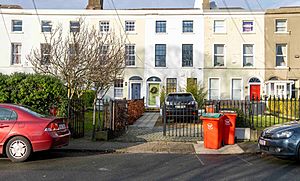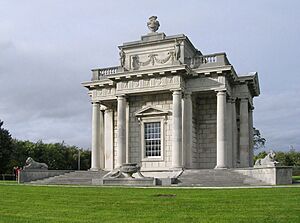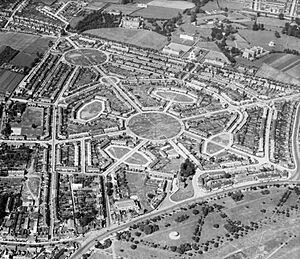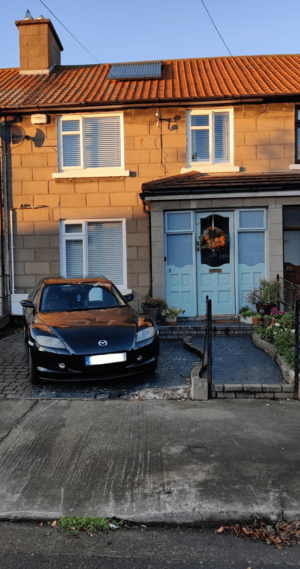Marino, Dublin facts for kids
Quick facts for kids
Marino
Irish: An Mairíne
|
|
|---|---|
|
Suburb
|
|

The Georgian-era Marino Crescent
|
|
| Country | |
| Province | Leinster |
| County | Dublin |
| Council | Dublin City Council |
| Dáil Éireann | Dublin Bay North |
| European Parliament | Dublin |
| Elevation | 4 m (13 ft) |
Marino (Irish: An Mairíne) is a suburb located on the Northside of Dublin, Ireland. It was carefully planned and built on land that once belonged to Marino House. This area is found between Drumcondra, Donnycarney, Clontarf, and Fairview. When it was first built, Marino featured about 1,300 houses made of concrete.
The design of Marino was greatly inspired by the Garden City Movement. This idea came from Sir Ebenezer Howard in the United Kingdom. Howard wanted to create towns that were the opposite of the crowded cities of his time. He imagined a "Garden City" as a perfect mix of country and city life. His ideas were shared in his book, Garden Cities of Tomorrow.
Contents
Where is Marino Located?
Marino is generally found within the roads of Sion Hill Road, Gracepark Road, Philipsburgh Avenue, Malahide Road, and Shelmartin Terrace. It shares borders with other Dublin areas like Fairview, Donnycarney, and Clontarf. Marino is only two kilometres away from the GPO on O'Connell Street. This makes it quite close to Dublin's city centre.
How to Get to Marino
The area is served by the Clontarf Road DART station. This train service connects Marino to other parts of Dublin. Dublin Bus also has route 123 running through Marino. Many other bus routes pass nearby, making it easy to travel around.
The History of Marino
Early Beginnings of Marino
The area known as Marino was once part of a larger piece of land called Donnycarney. This land was given to Dublin Corporation (the city's local government) by King Henry VIII. In 1787, a writer described Marino as a small village. It was about a mile past Drumcondra and two-and-a-half miles from Dublin Castle.
The famous Casino at Marino was built in 1759. It was a summer house on the grounds of Marino House, which was later taken down in the 1920s. There was even a secret tunnel connecting the Casino to the main house. This tunnel was used by servants.
How Marino Was Planned and Built
Marino was developed for housing in the late 1920s and 1930s. It was built on land that used to belong to the Earl of Charlemont. Marino is special because it was one of the first affordable housing projects in the new Irish Free State. It was also the first housing estate built by a local authority in Ireland. The design was strongly influenced by the garden city movement. When the houses were first built, they were mainly sold to large families.
In the early 1900s, Marino was seen as a good place for new homes. In 1910, a plan was made to build houses on a 50-acre site. However, concerns about land ownership and costs delayed the project. After a housing study in 1913, more plans were made. But political problems and World War I made building too expensive for the city. In 1918, Marino was again identified as a key area for housing.
The Dublin Corporation received a large grant to help fund this new housing plan. Before this, groups that helped people, like the Dublin Artisans' Dwellings Company, built homes for working-class families. The idea of a "garden suburb" was to move away from crowded city flats. This would create more spacious homes in the suburbs. It also aimed to reduce the spread of common diseases.
The original design for Marino was created by Frederick Hicks and H.T. O'Rourke. Charles McCarthy, the city architect, first suggested building 600 houses. But in 1919, O’Rourke presented plans that followed the garden city idea. Private companies built the houses. Some German builders were hired, which caused some discussion at the time. Each house cost between £550 and £590 to build. They were sold for an average of £450, which could be paid back over 40 years. All the houses were sold by 1925, with larger families getting priority.
The plans included a large circular green area called Marino Park. This park had smaller green areas like Marino Green next to it. The green in the middle of Croydon Park Avenue is known as the "D" walls. These green spaces give Marino a very unique look from above. Later housing projects followed similar designs.
Today, Marino has about 1,300 houses. Most of them were built using concrete, which was unusual then. Some older homes still have asbestos in their upstairs ceilings. This material needs to be removed safely when buying these buildings. People who lived in Marino in the early 1900s would still recognize the area. Not much has changed physically since then. When Marino was first built, people didn't need places to park cars. So, many residents have now changed their front gardens into driveways.
Marino is now considered close to the city centre. You can even walk there. Many bus routes also go through Fairview/Marino to the city centre. In 2011, about 3,000 people lived in Marino. This is a big change from the 10,000 people who lived there when it was first built. This is likely because families are smaller now. The types of jobs people have in Marino have also changed. Many now work in management or technical fields.
What Can You Find in Marino?
Marino has several schools for different age groups. These include St Vincent de Paul Infants' and Girls' National School, Scoil Mhuire CBS, and Ard Scoil Rís Secondary School. All these schools are located on Griffith Avenue, near the local church. Along Philipsburgh Avenue, there are many shops for local residents. These include a small supermarket, a pharmacy, a bakery, hairdressers, and butchers.
Marino is also home to Marino Institute of Education (MIE). This is a big part of the area, offering many courses to over 1,300 students. It is just north of the planned Garden City, on Griffith Avenue. Marino is also a short walk to DCU All Hallows Campus and DCU St Patrick's Campus.
Sports and Community in Marino
St Vincent's GAA Club is based in Marino at Pairc Naomh Uinsionn. This club has produced many famous football and hurling players. It has successful senior teams and a large youth section for almost a thousand boys and girls. Marino AFC plays soccer on one of the green areas. Marino/Fairview CY/LYMC is a pitch and putt and social club on Philipsburgh Avenue.
The Carlton Hall Community Centre on Shelmartin Avenue offers many activities. These include karate and other sports and social classes for the community. The Order of Malta Ambulance Corps also has a unit in Marino. They provide first aid support for local events.
The Casino at Marino: A Famous Building

The Casino is a very famous example of Irish neo-classical architecture. It was designed by William Chambers as a special pleasure house. It was built for James Caulfeild, the first Earl of Charlemont. Many people consider it one of the best 18th-century neo-classical buildings in Europe. The word "Casino" here means "small house." It has 16 beautifully decorated rooms inside. The Office of Public Works looks after the Casino. It is open to the public from April to October each year, and there is a small fee to enter.
Well-Known People from Marino
- Florence Balcombe, who was the wife of the famous novelist Bram Stoker.
- Billie Barry, who started a well-known stage school, lived on St Declan's Road.
- Harry Boland, a basketball player, lived at 5 Marino Crescent.
- William Carleton, a novelist, lived at 3 Marino Crescent.
- James Caulfeild, an important person from the 18th century.
- Dermot Desmond, a well-known businessman.
- John Francis Flynn, a folk singer.
- P. J. Gallagher, a comedian and broadcaster.
- Fintan Gavin, a Roman Catholic prelate and current Bishop of Cork and Ross.
- Martin Haverty, a journalist and historian.
- Tom Jordan, an actor.
- James Larkin, a trade union leader, lived in Croydon House.
- Cathal O'Shannon, a journalist and broadcaster.
- Michael Ryan, a broadcaster.
- John Sheahan, a member of the famous band The Dubliners.
- Alex White, a lawyer and former politician.
- Steve Wickham, a musician.
Religion in Marino
Marino is a parish in the Roman Catholic Archdiocese of Dublin. It is served by the Church of St Vincent de Paul.
See also
 In Spanish: Marino (Dublín) para niños
In Spanish: Marino (Dublín) para niños





